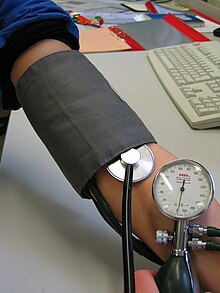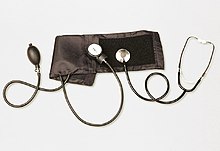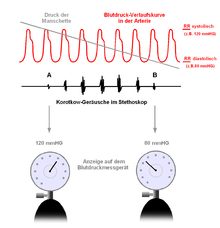Blood pressure measurement
When measuring blood pressure, a technical procedure is used to determine the pressure in a blood vessel. A distinction is made between the measurement of arterial pressure, venous pressure (e.g. central venous pressure ), and measurement in the pulmonary artery (pulmonary artery pressure) and in the pulmonary capillary area (pulmonary capillary pressure). While most methods require special examination procedures and in some cases special procedures are not part of the routine, the measurement of arterial pressure plays an important role in everyday medical practice, as it is easy to carry out.
Measurement of vascular pressure
A distinction is made between direct (invasive, bloody) pressure measurement using a pressure sensor in a blood vessel and indirect (non-invasive, bloodless) measurement, which is carried out on an extremity with the help of a cuff .
Direct pressure measurement

In the direct, invasive measurement (often abbreviated to "IBP", invasive blood pressure ), a vessel, usually a peripheral artery such as the radial artery or the femoral artery , is punctured and a catheter is inserted. This is connected to a pressure sensor , via which the arterial blood pressure curve can be displayed on a monitor . More Kanülierungsmöglichkeiten are the puncture of ulnar artery , brachial artery or Fußrückenarterie . The measurement is accurate and offers the advantage of continuous monitoring. In addition, the device determines the heart rate and the mean arterial pressure (MAP) for arterial pressure . Since the method is invasive , which involves the risk of bleeding, infection and nerve injuries, it is mainly used by anesthetists for monitoring during surgery and in intensive care units. Indications for invasive arterial pressure measurement are cardiopulmonary critically ill patients and major surgical interventions on the heart, vascular system, chest, liver or brain.
The venous pressure can also be determined in the venous system by means of invasive measurements. In this way, the central venous pressure (CVP, in the superior vena cava ) and, as part of a right heart catheter examination, which is ultimately analogous, the pulmonary artery (in the pulmonary artery ) and other pressures in the area of the right heart can be measured.
Indirect pressure measurement
In indirect arterial pressure measurement (often abbreviated to "NIBP", non-invasive blood pressure ), the arterial pressure is measured on an extremity, usually on the arm, with the help of a blood pressure monitor. While measurement in this way is not as accurate as the direct method, its ease, speed, safety, and inexpensive implementation make it the means of choice in most medical fields. A distinction is made between different measurement methods (see also blood pressure monitor ). It is important that the cuff is kept at the level of the heart during the entire process; this is particularly important for wrist devices. The manual measurement can be performed with auscultation, palpation and oscillation. The values of the individual methods differ slightly from one another.
During the auscultatory measurement , a pressure cuff of suitable width on the upper arm is inflated to above the expected arterial pressure. When the patient is drained slowly, the appearance and then the disappearance of a Korotkow sound can be heard with the aid of a stethoscope above the artery of the arm ( auscultation ). The pressure that can be read off the scale of the measuring device when the noise is first audible corresponds to the upper systolic arterial pressure value; d. That is, the systolic pressure at that moment is greater than the pressure of the cuff. The pressure is further released at an appropriate rate. If the cuff pressure falls below the minimum arterial pressure value, the noise disappears. This value is called the diastolic pressure and is noted as the lower value. Auscultatory measurement is the standard non-invasive measurement method.
A pressure cuff is also placed on the upper arm for the palpatory measurement . When the pressure is released, the pulse is felt at the radial artery. The pressure that can be read on the scale of the measuring device when the pulse is sampled for the first time corresponds approximately to the upper, systolic arterial pressure value. The diastolic value cannot be determined in this way. The method is suitable for z. B. noisy environments, especially in the ambulance service . The palpatory measurement without a pressure cuff is even more inaccurate, in which the radial artery is palpated with two fingers and the blood vessel is compressed with the finger closer to the heart until the pulse can no longer be felt with the finger further away from the heart. The force exerted by the finger closer to the heart is a rough guide to the blood pressure.
In principle, the oscillatory measurement is carried out like the other two methods; the upper and lower values are estimated on the basis of the amplitude curve of a pulse-synchronous pointer deflection on the measuring device, which shows the transmission of vibrations from the vessel wall to the pressure cuff. When measuring manually, this method only produces imprecise results. However, this measuring method is used quite reliably by measuring machines for continuous monitoring, e.g. B. used postoperatively in the recovery room . As an alternative to continuous invasive pressure measurement, these measure the patient's arterial pressure every few minutes. The oscillatory measuring method is also used in the now widely used wrist measuring devices.
Long-term blood pressure measurement (ABPM) is based on the same principle . The patient wears a blood pressure cuff permanently (usually for a whole day), which automatically inflates and measures itself at set intervals, as well as a recording device. This method is considered the gold standard for detecting and assessing the severity of arterial hypertension .
Unit of measurement and measurement accuracy
The millimeter of mercury (abbreviated mmHg ) is the legal unit in the European Union and Switzerland (written there without a hyphen). In the USA the unit Torr is used.
The deviation when measuring, the measuring accuracy, should be specified for the automatic devices (± 3 mmHg according to MPG). In the case of indirect measurements from "hand" (and ear) it is approximately plus / minus 5 mmHg, but depends on compliance with certain rules that have been agreed by national or international specialist societies (lowering speed, time of measurement). If these rules are not observed, deviations in the range of plus / minus 10 mmHg would quickly arise. The measuring accuracy of the individual measurement is therefore mostly in a range that has no immediate therapeutic consequence.
Methodology and sources of error
methodology
The measurement should be carried out after five minutes of rest in a quiet room and if possible while sitting. The pressure cuff must be correctly selected. In the case of patients taking medication, it should be noted when the measurement in relation to medication intake was taken. If there are differences between the two arms, the measurement should be made on the arm with the higher arterial pressure. To assess the arterial pressure level, the mean value from several successive measurements should be taken, in the case of diagnostic questions, at every visit to the doctor.
Sources of error
Possible sources of error are, for example, incorrectly calibrated (in the middle of the thorax or heart level) or unsuitable devices. With indirect arterial pressure measurement, the width of the cuff is particularly important; cuffs that are too narrow measure values that are too high and vice versa.
Other errors are caused by the person measuring: the diastolic value is incorrectly assumed to be too high due to a phenomenon that can sometimes be observed, the "auscultatory gap" (in this case the noise phenomena disappear temporarily in a medium pressure range), the number of measurements is too high low, a check is not carried out on the other arm, the pressure release rate is too high (more than 3 mmHg / s), the results are incorrectly noted. During the first measurement, the systolic arterial pressure during inflation should therefore also be determined by palpation and the cuff inflated 30 mm Hg above this pressure.
A source of error for the interpretation of the measurement results lies in the situation in which the measurement is carried out. In stressful and unfamiliar situations, the arterial pressure will be measured correctly, but will not correspond to the normal level. This can e.g. B. be the case when visiting a doctor ( white coat hypertension ).
The following influencing factors are mentioned in Der Hausarzt 15/09, p. 54 f:
| Effect on the systolic value in mmHg |
Effect on the diastolic value in mmHg |
|
|---|---|---|
| Urination or urination | up to +27 | up to +22 |
| White coat effect | up to +22 | up to +14 |
| Speak | +17 | +13 |
| Smoke | +10 | +8 |
| drink coffee | +10 | +7 |
| Acute cold (drafts) | +11 | +8 |
| Lack of back support | +8 | +6 ... +10 |
| Cuff too narrow | −8 | +8 |
| Legs crossed | variable | |
| Emotional burden | variable |
Blood pressure measurement in veterinary medicine
In veterinary medicine (apart from emergencies) blood pressure is determined indirectly using a measuring device. The cuff is placed on the front paw or tail of a dog or cat, for example. Signs of high blood pressure can be increased water requirements, dull hair, enlarged pupils or reduced activity. In cats the blood pressure is in the normal range of about 124/84 mmHg, in dogs at 133/75 mmHg, but each breed of dog has its specific normal value. Even in animals, a stressful situation at the veterinarian's can give the impression of hypertension with the measured values. It is recommended to measure blood pressure at least once a year as a preventive measure, and more frequently in sick animals.
history
Around 1713 Stephen Hales (1677–1761) carried out the invasive, bloody measurement in the veterinary field for the first time.
An early device for indirect arterial pressure measurement was z. B. the sphygmograph of the German physiologist Karl von Vierordt (1818-1884). The first sphygmomanometer was invented by the Austrian pathologist Samuel Siegfried Karl Ritter von Basch (1837–1905), the family doctor of Maximilian I.
A simple method of the sphygmomanometer using mercury was invented by the Italian doctor Scipione Riva-Rocci and published in 1896. Therefore, the arterial pressure values measured according to this principle are often marked with "RR" . In 1901 Harvey Cushing discovered this method on a trip to Italy, improved it for clinical application and popularized it.
Around 1905, the Russian military doctor Nikolai Sergejewitsch Korotkow extended the method to include the measurement of diastolic pressure by using the stethoscope to hear the Korotkow noises later named after him .
Heinrich von Recklinghausen used a wide cuff that could only measure the actual arterial pressures, in contrast to the thin rubber cuff from Riva-Rocci (see the measurements by Müller and Blauel from 1907 with a difference of 40%). It was only through his use of a spring or capsule manometer that measurements could also be made using an oscillometric method.
See also
Arterial hypertension # classifications
Web links
literature
- S. Eckert: 100 Years of Blood Pressure Measurement According to Riva-Rocci and Korotkoff: Review and Outlook . J Hypertension 2006; 10 (3): 7-13 ( online ).
- O. Gefeller, H. Steinberg: Blood pressure measurement in practice . ZfA 1992: 192-196.
- Klaus Holldack, Klaus Gahl: Auscultation and percussion. Inspection and palpation. Thieme, Stuttgart 1955; 10th, revised edition, ibid. 1986, ISBN 3-13-352410-0 , pp. 211-219 (measuring blood pressure on the arms ).
Individual evidence
- ↑ Reinhard Larsen: Anesthesia and intensive medicine in cardiac, thoracic and vascular surgery. (1st edition 1986) 5th edition. Springer, Berlin / Heidelberg / New York et al. 1999, ISBN 3-540-65024-5 , p. 124 f.
- ↑ Herbert Lippert: Anatomy on the living: An exercise program for medical students . Springer-Verlag, Berlin / Heidelberg 2013, ISBN 978-3-662-00661-0 , p. 285 ( limited preview in Google Book search).
- ↑ a b c d Guidelines for the prevention, detection, diagnosis and therapy of arterial hypertension of the German Hypertension League, online at AWMF ( Memento from September 16, 2008 in the Internet Archive ).
- ↑ Christoph Piesbergen, Martin Middeke, Willi Butollo: Lowering blood pressure without side effects: Diagnosis and therapy of hypertension through high-frequency biofeedback . In: Hypnosis and Cognition . tape 13 , no. 1 + 2 , p. 211–223 , urn : nbn: de: bvb: 19-epub-11149-0 (free full text).
- ↑ Reinhard Larsen: Anesthesia and intensive medicine in cardiac, thoracic and vascular surgery. 1999, p. 124.
- ^ Roger Dobson: Blood pressure readings may be wrong for overweight patients . In: BMJ . tape 327 , no. 7413 , August 2003, p. 468 , doi : 10.1136 / bmj.327.7413.468-a .




